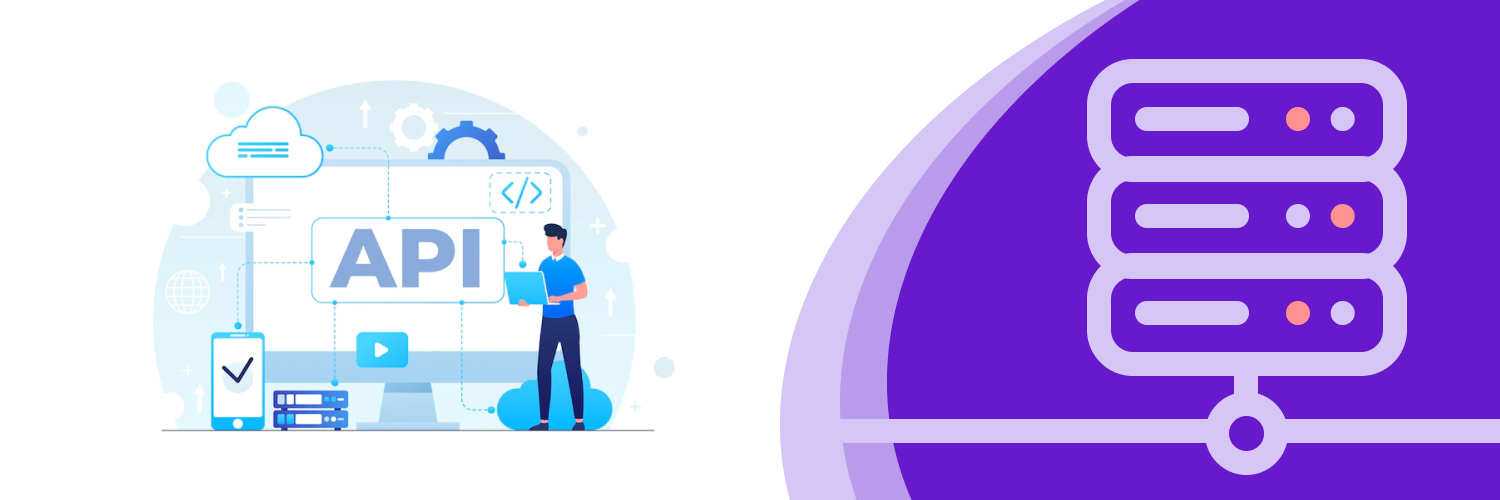Do you want to learn what an API proxy is? Then we can help. APIs, proxies, and API proxies will be talked about in-depth within this article, covering their known use cases, the types of API proxies that can be used, why you should use them, the difference between an API proxy vs API gateway, and more.
Table of Contents
What Is An API?

API is the acronym for Application Programming Interface. It is a software intermediary that lets two applications communicate with each other. Developers can use APIs to easily access application logic and data that has been built by other developers.
When you use apps on your phone, those apps will connect to the internet and send data to a specific server. That server will then retrieve and interpret the data, perform the necessary actions and send the data back to your phone so you can see and understand it. All of this can happen because of APIs.
What Are Proxies And What Are Their Use Cases?

A proxy server will act as the gateway between you and the internet. It’s a server that separates users from the websites they are browsing, by acting as the intermediary. Proxies can provide functionality, privacy, and security based on your needs. They will behave as the firewall and filter the web requests to keep you protected when you’re connected to the internet.
Known Uses Cases For Proxies
Gathering data
Proxies can be used to collect data in real-time. Using this reliably gathered data, you can analyze changes, identify trends, and make the best decisions that will help you succeed and achieve your goals.
You can use proxies to view the web from the perspective of different users and people around the world. This perspective can help you manage what is being seen by all users and make changes using this new information.
Monitoring search engines
Proxies are used by people and businesses to track keywords and trends in specific markets. This helps to collect data on what different users are seeing, what is trending, and what is performing poorly. All of this data can be analyzed to help improve performance. An SEO API can be used with proxies to help developers to add SEO (Search Engine Optimization) features to applications.
To increase protection
Businesses and people use proxies to protect their information on the web. A proxy can be used to find certain activities that are unauthorized and help prevent them. Once the activities, such as the unauthorized use of your information have been found, you can then take the required actions against them.
What Is An API Proxy?

An API proxy is a type of gateway between the developers and the backend services. The API (Application Programming Interface) proxy will make requests for the developers and act as an intermediary between the application and the backend services that are required, by providing an interface for the developers.
API proxies allow the developers to define an API without having to change the underlying backend services. This is done by decoupling the frontend API from the backend services, protecting the applications from changes made to the backend code. The applications will be able to communicate with the API like usual and the changes to the backend code will not have any effect.
HTTP/HTTPS API proxies
HTTP stands for Hypertext Transfer Protocol and HTTPS stands for Hypertext Transfer Protocol Secure. These are used for data exchanges on the internet. A HTTP/HTTPS API proxy is specifically used for these types of connections, usually over a web browser.
This API proxy will act as the intermediary between a server and the web browser which is usually the client. This is done by transmitting the requests and then delivering the required resources back to the client in the HTTP/HTTPS format so they can be viewed.
You can configure the ProxyEndpoint (client-side) to define the URL of an API proxy. This will cause applications to access the API proxy over a HTTP connection or a HTTPS connection.
The TargetEndpoint (back-end) can be configured to send requests to a specific backend service. The configuration includes security settings, the HTTP or HTTPS protocol, and more.
SOCKS API proxies
SOCKS stands for Socket Secure, and it’s an internet protocol. These types of proxies use a Transmission Control Protocol (TCP) connection to send and receive data packets over the internet through a proxy server. SOCKS API proxies cannot interpret web data. They work with any kind of network protocol on any port that’s needed. SOCKS5 is the latest version of the SOCKS protocol.
This type of API proxy can be configured to do what is required as well. SOCKS API proxies are more flexible as they aren’t bound to specific network protocols. The faster speeds offered by SOCKS make them the best choice for larger data transfers between the client and server.
Proxy Provider
A proxy provider is the intermediary between your computer (client) and the internet. The APIs offered by the proxy provider have been built and tested to work. Different providers will have their own way of doing things, so you will need to find out more information about those APIs from the providers themselves.
What Is An API Gateway?

An API gateway is a tool used for API management. It acts as the intermediary between the client and a collection of backend services so it can send and receive requests and data. An API gateway will receive calls, aggregate the services that are needed to fulfill the calls, and then it will return a result.
Why You Need an API Gateway Proxy

The API gateway proxy will act as the entry point across all the internal APIs that are being used. This makes it easier to control user access to the APIs. This control will help improve the security measures and handle things such as rate-limiting, user authentication, and gathering data to understand how APIs are being used.
API Proxy Vs API Gateway
An API proxy is a lightweight version of an API gateway. While it has some security and monitoring features, it is relatively basic compared to what an API gateway has to offer. If you don’t need complex features, then you can use an API proxy and that will work without any issues.
An API gateway will give you access to features that an API proxy cannot. If you need features such as service orchestration, mediation, transformation, and Dos prevention, then you need to use an API gateway.
Conclusion

The complexity of APIs and API proxies is growing and understanding them and how they can be used is important. You need to define your requirements before choosing an API proxy, as this makes a big difference in data transfer and how efficient it will be. Using an API gateway is one method of controlling and managing API proxies to get the data that you need so you can make the best decisions to help you achieve your goals successfully.




